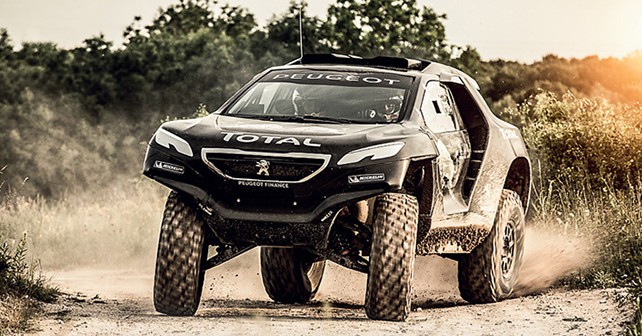Twenty-five years after Peugeot last competed in the Dakar rally, the French carmaker returns to the mother of all rallies – now being held in South America. In a daring gamble, Peugeot has chosen to compete with a rear-drive vehicle to challenge the all-wheel drive defending-champion – the Mini Countryman.
Nine thousand kilometres, 13 stages that cross the Andes mountain range four times – that’s what the Dakar rally will entail when it’s flagged off on the 4th of January 2015 in Buenos Aires (it ends on the 17th of January in the same city). But the world’s longest and toughest cross-country rally may have just got tougher. After three years of undisputed leadership by the Volkswagen Touareg, and then another two years by the Mini All4 Racing by X-raid, French manufacturer Peugeot is now trying to muscle in.
The 2015 edition of the Dakar Rally will also involve two completely opposite schools of thought as far as the technology of the machines is concerned. On one side, there’s the Mini, which confirms the successful technical layout of the cars that took part in the previous editions of the rally – a six-cylinder diesel engine of BMW origin, a 3-litre twin-turbo with a 38mm diameter air intake restrictor as per the rally guidelines. The Mini generates 320bhp and a massive torque figure of 800Nm at 2,100rpm. It has an Xtrac four-wheel drive system, a Sadev six-speed sequential gearbox, and the look of a Countryman that’s gone through some pretty intense bodybuilding.
On the other hand, the Peugeot 2008 DKR, which hopes to replicate the French carmaker’s glory days of the late 1980s (which featured four victories in a row, with the 205T16 and the 405T16), is a rear-wheel drive SUV.
Bruno Famin, Director of Peugeot Sport, explains the reasons behind this controversial technical choice. "There are two sets of reasons,” he says, supervising the final phase of assembly work of all the cars, which will be tested once more in Morocco before being sent to Buenos Aires, "and the first one is purely technical. The rally regulations grant some 'bonus' advantages to all the two-wheel drive vehicles, which are at a disadvantage in terms of traction – bigger tyres, much higher suspension travel (450mm instead of 260mm), less minimum weight, and the chance to inflate and deflate the tyres while on the move, which is very relevant on sand. So, on sand dunes, you don’t need to stop in order to decrease tyre pressure, and then increase it again."
“The second reason is a strategic one. The Mini is a car that has been improved year-after-year, reaching an optimal performance level. Opting for the same design philosophy would have created the risk of taking too much time to develop a car that could defeat it. So it’s better to follow a different path. It’s the same logic that we followed at Le Mans when we launched the 908 HDi with closed bodywork against the open cabin design of the Audi. After sometime, they had to opt for the same solution as us at Ingolstadt too. Of course, if it rains too much at Dakar, there’s going to be mud everywhere, and we might regret this decision.”
TURBO IS A MUST
But the Peugeot 2008 DKR’s engine is more or less similar to the one that powers the Mini. Peugeot also relies on a twin-turbo diesel engine, a centrally mounted 3 litre 24-valve V6, generating 340bhp and 800Nm of torque. What are the advantages of this kind of engine? “Well, the regulations don’t allow petrol turbocharged engines,” says Famin, “because of the long stage distances, their huge fuel consumption would make the competitors carry too much petrol on board – increasing the risks. But the turbo is essential to compensate for the power loss due to the altitude, especially this year since the rally route will cross several areas above 3,000 meters in height. So, we can state that our choice of engine was more for the turbo than the diesel fuel.”
The challenge is therefore very much open. One would have thought that Peugeot, which has launched a three-year Dakar plan, would be pleased enough if its cars complete the rally in their first year. But the choice of the drivers leaves no one in any doubt about its ambitions of a podium finish. Stephane Peterhansel, snatched away from Mini, has already won 11 Dakar rallies, six of them on a bike; Carlos Sainz triumphed in 2010 with the Touareg, and he’s also been World Rally Champion twice; Cyril Despres is a new comer on four wheels, but he has already won Dakar five times on a bike. There could be no better team!
MONEY MATTERS
The final look of the Peugeot 2008 DKR (at the bottom, compared to the 2015 Mini of Nani Roma) carries the colours of Red Bull, who are supporting the French manufacturer in this adventure – after having been in its camp during the 2013 American Pikes Peak hill climb. The presence of a strong sponsor is essential to take on such a challenge. “We have a small budget,” concedes Bruno Famin, Director of Peugeot Sport, “when compared what we would have for other categories, such as the World Endurance Championship and the World Rally Championship.” But the rally offers a chance to bring visibility to the car company in the areas they’re more interested at the moment. “In Latin America, the following is huge,” Famin declares, “but we are also going to race in China.”

© Riproduzione riservata






























Write your Comment